Spatiotemporal Variation in Air Pollution Characteristics and Influencing Factors in Ulaanbaatar from 2016 to 2019
Abstract
:1. Introduction
2. Materials and Methods
2.1. Overview of the Research Area
2.2. Materials and Methods
2.2.1. Air Quality Index and Pollutant Concentration Limits
2.2.2. Data Sources
2.2.3. Data Processing
3. Results and Analysis
3.1. Ambient Air Quality
3.2. Variation in Particulate Matter over Time
3.2.1. Year-to-Year Changes in Particulate Matter
3.2.2. Seasonal Variation in Particulate Matter
3.2.3. Month-to-Month Changes in Particulate Matter
3.2.4. Hourly Variation in Particulate Matter
3.3. Analysis of Pollution Types
3.4. The Relationship between PM2.5 and Five Other Pollutants
4. Conclusions and Future Perspectives
Author Contributions
Funding
Institutional Review Board Statement
Informed Consent Statement
Data Availability Statement
Conflicts of Interest
References
- Boogaard, H.; Walker, K.; Cohen, A.J. Air pollution: The emergence of a major global health risk factor. Int. Health 2019, 11, 417–421. [Google Scholar] [CrossRef] [PubMed]
- Bai, J.; de Leeuw, G.; De Smedt, I.; Theys, N.; Van Roozendael, M.; Sogacheva, L.; Chai, W. Variations and photochemical transformations of atmospheric constituents in North China. Atmos. Environ. 2018, 189, 213–226. [Google Scholar] [CrossRef]
- Shi, X. Air pollution, climate change and health: From evidence to action. Chin. J. Prev. Med. 2019, 53, 1–3. [Google Scholar]
- Ding, Y.; Zhong, J.; Guo, G.; Chen, F. The impact of reduced visibility caused by air pollution on construal level. Psychol. Mark. 2021, 38, 129–141. [Google Scholar] [CrossRef]
- Zhang, J.J.; Adcock, I.M.; Bai, Z.; Chung, K.F.; Duan, X.; Fang, Z.; Gong, J.; Li, F.; Miller, R.K.; Qiu, X. Health effects of air pollution: What we need to know and to do in the next decade. J. Thorac. Dis. 2019, 11, 1727. [Google Scholar] [CrossRef]
- WHO. Ambient (Outdoor) Air Pollution. Available online: https://www.who.int/news-room/fact-sheets/detail/ambient-(outdoor)-air-quality-and-health (accessed on 22 September 2021).
- Lin, B.; Zhu, J. Changes in urban air quality during urbanization in China. J. Clean. Prod. 2018, 188, 312–321. [Google Scholar] [CrossRef]
- Ma, Y.-R.; Ji, Q.; Fan, Y. Spatial linkage analysis of the impact of regional economic activities on PM2. 5 pollution in China. J. Clean. Prod. 2016, 139, 1157–1167. [Google Scholar] [CrossRef]
- Hao, Y.; Liu, Y.-M. The influential factors of urban PM2. 5 concentrations in China: A spatial econometric analysis. J. Clean. Prod. 2016, 112, 1443–1453. [Google Scholar] [CrossRef]
- Zeng, Y.; Cao, Y.; Qiao, X.; Seyler, B.C.; Tang, Y. Air pollution reduction in China: Recent success but great challenge for the future. Sci. Total Environ. 2019, 663, 329–337. [Google Scholar] [CrossRef]
- Holman, C.; Harrison, R.; Querol, X. Review of the efficacy of low emission zones to improve urban air quality in European cities. Atmos. Environ. 2015, 111, 161–169. [Google Scholar] [CrossRef]
- Verbeek, T.; Hincks, S. The ‘just’management of urban air pollution? A geospatial analysis of low emission zones in Brussels and London. Appl. Geogr. 2022, 140, 102642. [Google Scholar] [CrossRef]
- WHO. World Health Statistics 2020: Monitoring Health for the SDGs, Sustainable Development Goals; WHO: Geneva, Switzerland, 2020. [Google Scholar]
- Guttikunda, S. Urban air pollution analysis for Ulaanbaatar, Mongolia. SIM Working Paper No. 2008-005(September 22, 2008). Available online: https://ssrn.com/abstract=1288328 (accessed on 10 May 2022).
- Guttikunda, S.K.; Lodoysamba, S.; Bulgansaikhan, B.; Dashdondog, B. Particulate pollution in Ulaanbaatar, Mongolia. Air Qual. Atmos. Health 2013, 6, 589–601. [Google Scholar] [CrossRef]
- Ganbat, G.; Baik, J.-J. Wintertime winds in and around the Ulaanbaatar metropolitan area in the presence of a temperature inversion. Asia-Pac. J. Atmos. Sci. 2016, 52, 309–325. [Google Scholar] [CrossRef]
- Ganbat, G.; Soyol-Erdene, T.-O.; Jadamba, B. Recent improvement in particulate matter (PM) pollution in Ulaanbaatar, Mongolia. Aerosol Air Qual. Res. 2020, 20, 2280–2288. [Google Scholar] [CrossRef]
- Dashdendev, B.; Fukushima, L.K.; Woo, M.S.; Ganbaatar, E.; Warburton, D. Carbon monoxide pollution and lung function in urban compared with rural Mongolian children. Respirology 2011, 16, 653–658. [Google Scholar] [CrossRef]
- Yoshihara, S.; Munkhbayarlakh, S.; Makino, S.; Ito, C.; Logii, N.; Dashdemberel, S.; Sagara, H.; Fukuda, T.; Arisaka, O. Prevalence of childhood asthma in Ulaanbaatar, Mongolia in 2009. Allergol. Int. 2016, 65, 62–67. [Google Scholar] [CrossRef] [Green Version]
- Shah, P.S.; Balkhair, T.; Knowledge Synthesis Group on Determinants of Preterm/LBW births. Air pollution and birth outcomes: A systematic review. Environ. Int. 2011, 37, 498–516. [Google Scholar] [CrossRef]
- Conforti, A.; Mascia, M.; Cioffi, G.; De Angelis, C.; Coppola, G.; De Rosa, P.; Pivonello, R.; Alviggi, C.; De Placido, G. Air pollution and female fertility: A systematic review of literature. Reprod. Biol. Endocrinol. 2018, 16, 1–9. [Google Scholar] [CrossRef]
- Enkhmaa, D.; Warburton, N.; Javzandulam, B.; Uyanga, J.; Khishigsuren, Y.; Lodoysamba, S.; Enkhtur, S.; Warburton, D. Seasonal ambient air pollution correlates strongly with spontaneous abortion in Mongolia. BMC Pregnancy Childbirth 2014, 14, 1–7. [Google Scholar] [CrossRef] [Green Version]
- Qing, W. Urbanization and global health: The role of air pollution. Iran. J. Public Health 2018, 47, 1644. [Google Scholar]
- Diener, A.C.; Batjav, B. Axial Development in Mongolia: Intended and unintended effects of new roads. Mobilities 2019, 14, 778–794. [Google Scholar] [CrossRef]
- Yingying, Y.; Ning, Z. System Simulation Analysis of Air Pollution Effect in China’s Urbanization Development. Urban Probl. 2020. [Google Scholar]
- NSO of Mongolia. Effects of Air Pollution on Human Health in Ulaanbaatar; NSO of Mongolia: Ulaanbaatar, Mongolia, 2020. Available online: https://1212.mn/ (accessed on 1 January 2020).
- Han, J.; Dai, H.; Gu, Z. Sandstorms and desertification in Mongolia, an example of future climate events: A review. Environ. Chem. Lett. 2021, 19, 4063–4073. [Google Scholar] [CrossRef] [PubMed]
- Tserenbat, N. Procedures for Assessing and Reporting Air Quality by Air Quality Index (Агаарын чанарын индексээр агаарын чанарыг үнэлэх, мэдээлэх журам). Available online: http://agaar.mn/article-view/692 (accessed on 1 October 2018).
- Zhen-fang, H.; Qing-chun, G.; Jia-zhen, L.; Ying-ying, Z.; Jie, L.; Hang, D. Spatio-temporal variation characteristics of air pollution and influencing factors in Hebei province. J. Nat. Resour. 2021, 36, 411–419. [Google Scholar]
- Xu, G.; Jiao, L.; Zhang, B.; Zhao, S.; Yuan, M.; Gu, Y.; Liu, J.; Tang, X. Spatial and temporal variability of the PM2. 5/PM10 ratio in Wuhan, Central China. Aerosol Air Qual. Res. 2017, 17, 741–751. [Google Scholar] [CrossRef] [Green Version]
- Coskuner, G.; Jassim, M.S.; Munir, S. Characterizing temporal variability of PM2. 5/PM10 ratio and its relationship with meteorological parameters in Bahrain. Environ. Forensics 2018, 19, 315–326. [Google Scholar] [CrossRef]
- Speranza, A.; Caggiano, R.; Margiotta, S.; Summa, V.; Trippetta, S. A clustering approach based on triangular diagram to study the seasonal variability of simultaneous measurements of PM10, PM2. 5 and PM1 mass concentration ratios. Arab. J. Geosci. 2016, 9, 1–8. [Google Scholar] [CrossRef]
- Liu, J.; Mauzerall, D.L.; Chen, Q.; Zhang, Q.; Song, Y.; Peng, W.; Klimont, Z.; Qiu, X.; Zhang, S.; Hu, M.; et al. Air pollutant emissions from Chinese households: A major and underappreciated ambient pollution source. Proc. Natl. Acad. Sci. USA 2016, 113, 7756–7761. [Google Scholar] [CrossRef] [Green Version]
- Huang, R.-J.; Zhang, Y.; Bozzetti, C.; Ho, K.-F.; Cao, J.-J.; Han, Y.; Daellenbach, K.R.; Slowik, J.G.; Platt, S.M.; Canonaco, F.; et al. High secondary aerosol contribution to particulate pollution during haze events in China. Nature 2014, 514, 218–222. [Google Scholar] [CrossRef] [Green Version]
- Huang, W.; Long, E.; Wang, J.; Huang, R.; Ma, L. Characterizing spatial distribution and temporal variation of PM10 and PM2.5 mass concentrations in an urban area of Southwest China. Atmos. Pollut. Res. 2015, 6, 842–848. [Google Scholar] [CrossRef]
- Liu, Z.; Hu, B.; Wang, L.; Wu, F.; Gao, W.; Wang, Y. Seasonal and diurnal variation in particulate matter (PM10 and PM2.5) at an urban site of Beijing: Analyses from a 9-year study. Environ. Sci. Pollut. Res. 2015, 22, 627–642. [Google Scholar] [CrossRef] [PubMed]
- Zheng, Z.; Xu, G.; Li, Q.; Chen, C.; Li, J. Effect of precipitation on reducing atmospheric pollutant over Beijing. Atmos. Pollut. Res. 2019, 10, 1443–1453. [Google Scholar] [CrossRef]
- Wallace, J.; Kanaroglou, P. The effect of temperature inversions on ground-level nitrogen dioxide (NO2) and fine particulate matter (PM2.5) using temperature profiles from the Atmospheric Infrared Sounder (AIRS). Sci. Total Environ. 2009, 407, 5085–5095. [Google Scholar] [CrossRef] [PubMed]
- Allen, R.W.; Gombojav, E.; Barkhasragchaa, B.; Byambaa, T.; Lkhasuren, O.; Amram, O.; Takaro, T.K.; Janes, C.R. An assessment of air pollution and its attributable mortality in Ulaanbaatar, Mongolia. Air Qual. Atmos. Health 2013, 6, 137–150. [Google Scholar] [CrossRef] [PubMed] [Green Version]
- Liang, L.-S.; Jing, J.-L.; Wang, A.-N.; Luo, F.-L. Spatial-temporal distribution characteristics of PM2. 5 concentrations in Beijing-Tianjin-Hebei region in winter from 2014 to 2019. J. Guilin Univ. Technol. 2020, 40, 788–797. [Google Scholar]
- Kim, J.; Han, B.; Baik, J. Temporal and spatial variations of workday-holiday particulate matter concentration differences in Seoul. J. Korean Soc. Atmos. Environ. 2020, 36, 25–30. [Google Scholar] [CrossRef]
- Xu, L.; Batterman, S.; Chen, F.; Li, J.; Zhong, X.; Feng, Y.; Rao, Q.; Chen, F. Spatiotemporal characteristics of PM2.5 and PM10 at urban and corresponding background sites in 23 cities in China. Sci. Total Environ. 2017, 599, 2074–2084. [Google Scholar] [CrossRef]
- Wang, Y.; Ma, Y.; Lu, Z.; Li, C.; Liu, N. Analysis of weather conditions and air pollution status during continuous fog days of Liaoning. Environ. Sci. Technol 2010, 33, 289–291. [Google Scholar]
- Wang, S.; Liao, T.; Wang, L.; Sun, Y. Process analysis of characteristics of the boundary layer during a heavy haze pollution episode in an inland megacity, China. J. Environ. Sci. 2016, 40, 138–144. [Google Scholar] [CrossRef]
- Xinchun, L.; Hongna, C.; Kelei, Z.; Yuting, Z.; Jingwu, Y. Analysis on the Size Distribution of Atmospheric Aerosol and the Mass Concentration Change Characteristics of Fine Particulate Matter (PM2.5). Ecol. Environ. Sci. 2016, 25, 605–613. [Google Scholar]
- Wang, M.; Kai, K.; Sugimoto, N.; Enkhmaa, S. Meteorological factors affecting winter particulate air pollution in Ulaanbaatar from 2008 to 2016. Asian J. Atmos. Environ. 2018, 12, 244–254. [Google Scholar] [CrossRef]
- Zakaria, U.; Saudi, A.; Abu, I.; Azid, A.; Balakrishnan, A.; Amin, N.; Rizman, Z. The assessment of ambient air pollution pattern in Shah Alam, Selangor, Malaysia. J. Fundam. Appl. Sci. 2017, 9, 772–788. [Google Scholar] [CrossRef] [Green Version]
- Ding, M.-M.; Zhou, J.-N.; Liu, B.-X.; Wang, Y.; Zhang, B.-T.; Shi, A.-J.; Yang, D.-Y.; Chang, M. Pollution characteristics of NH4+, NO3−, SO42− in PM2.5 and their precursor gases during 2015 in an urban area of Beijing. Huan Jing Ke Xue Huanjing Kexue 2017, 38, 1307–1316. [Google Scholar] [PubMed]


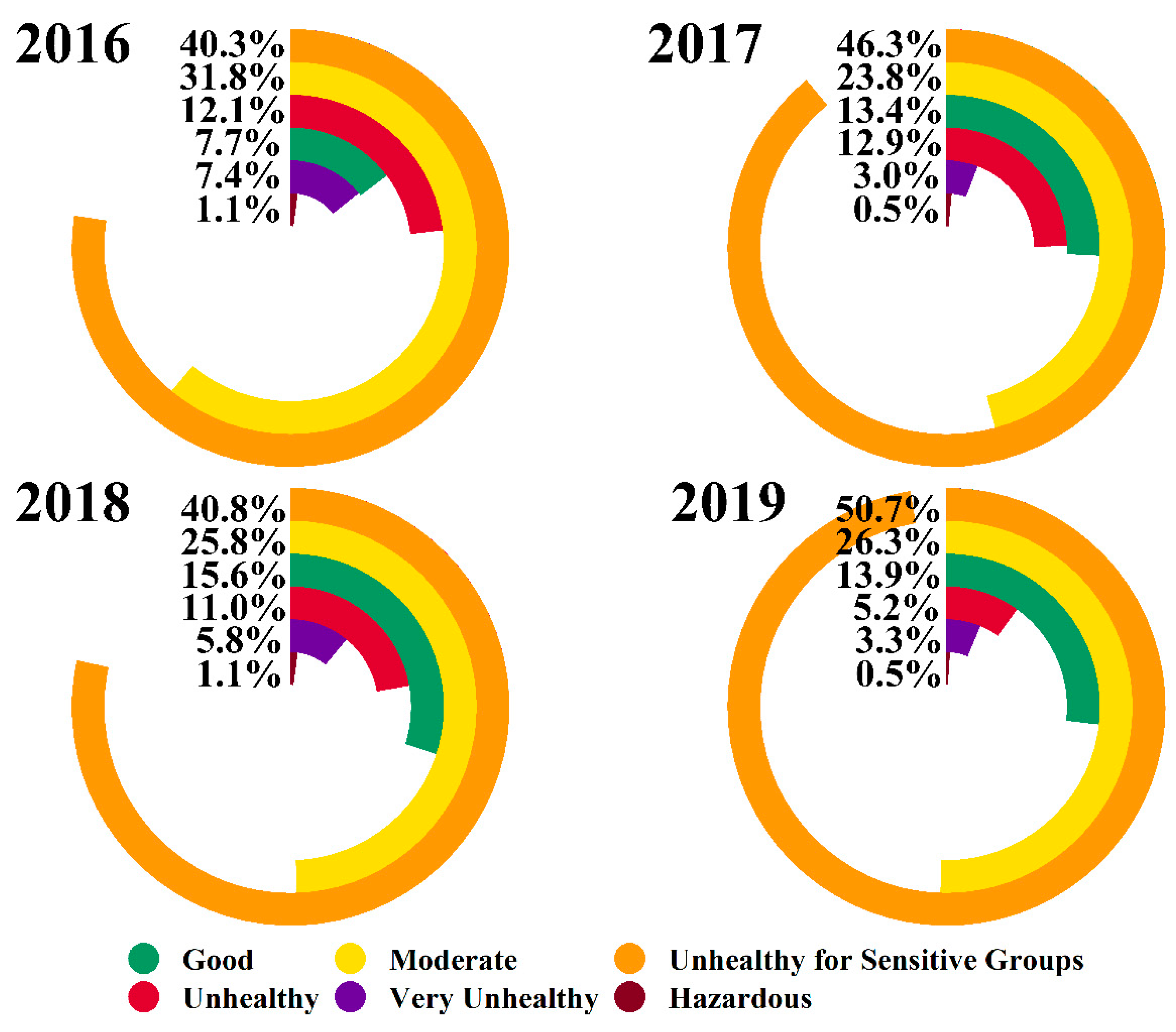


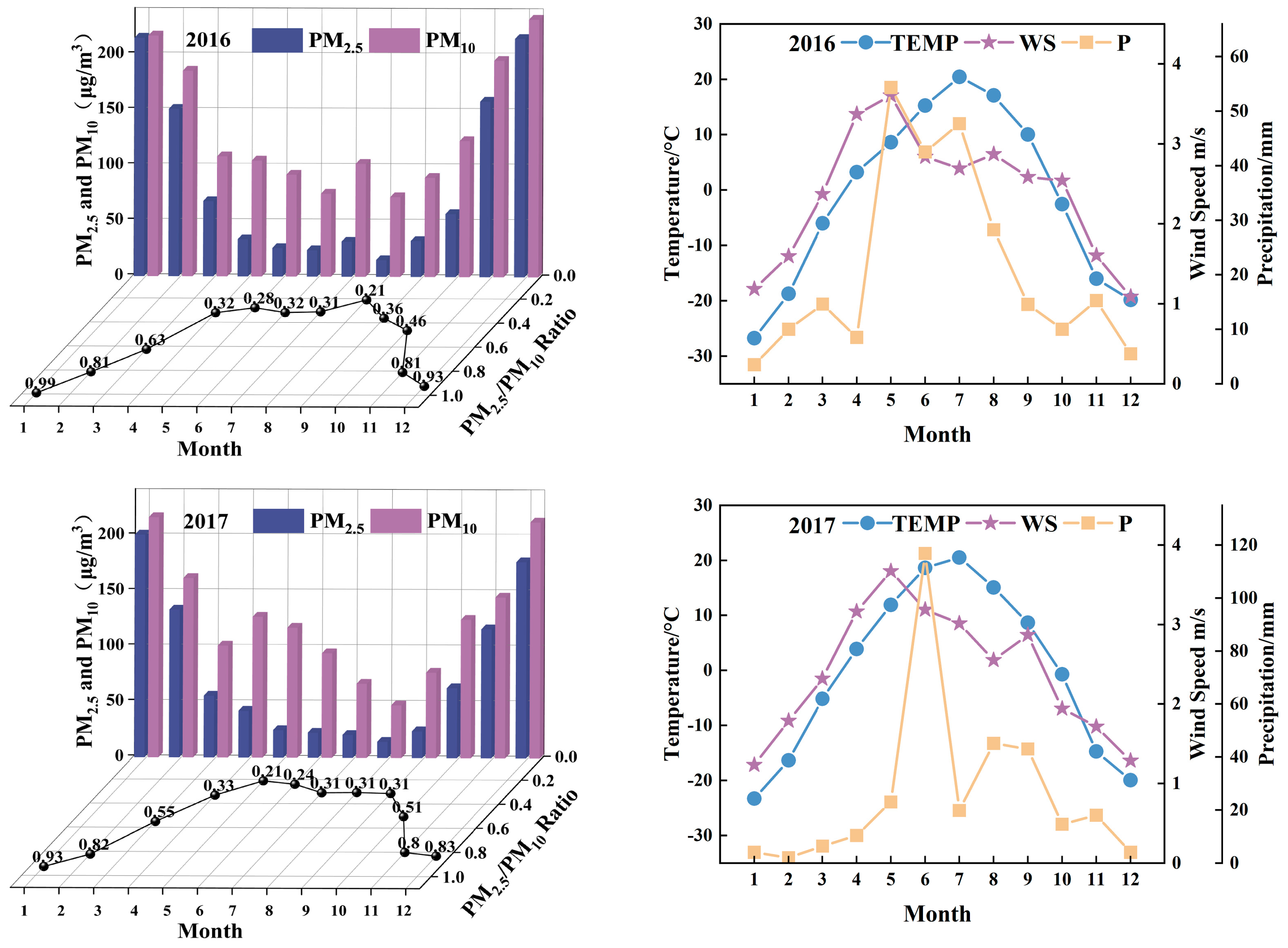
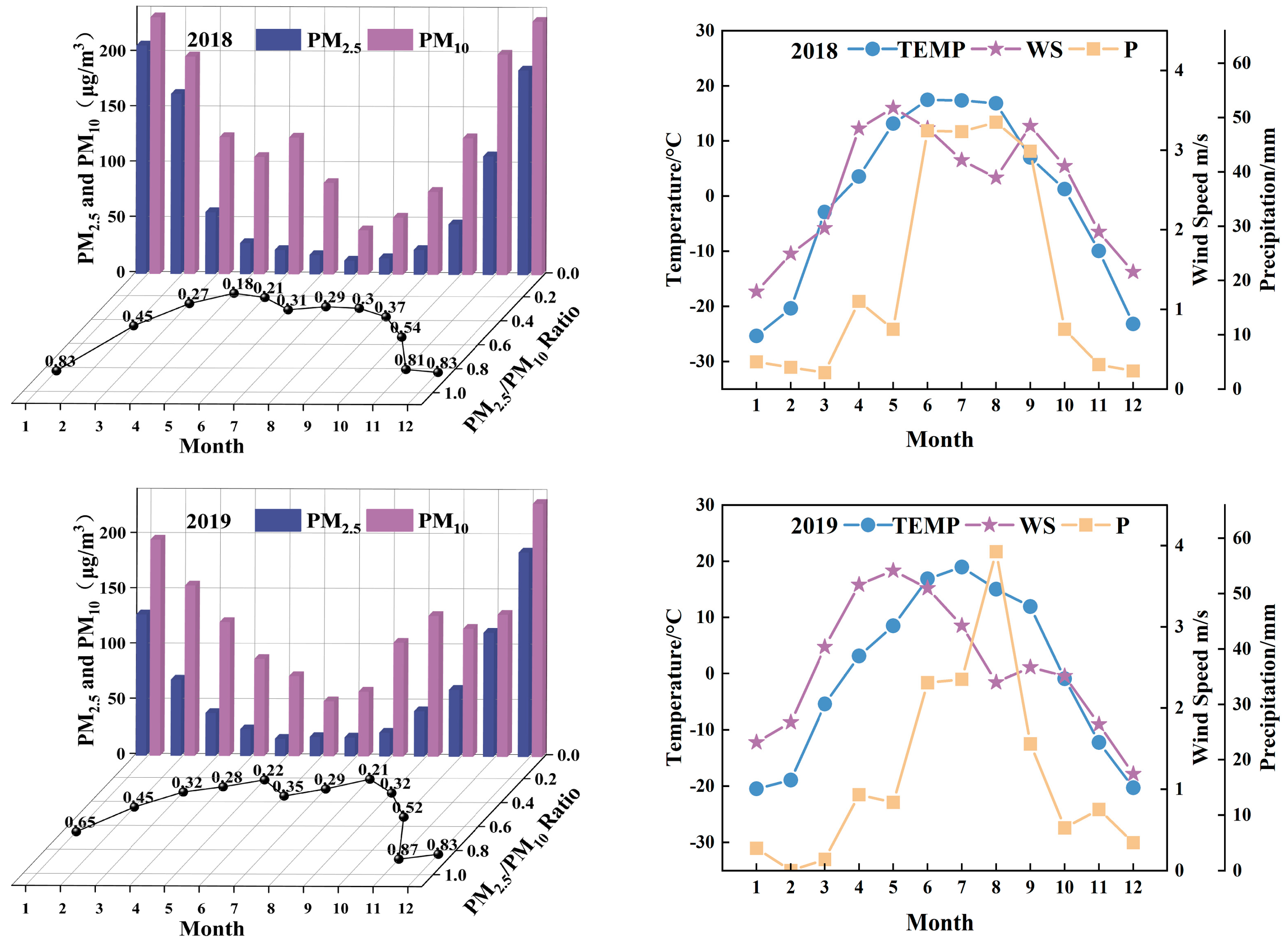

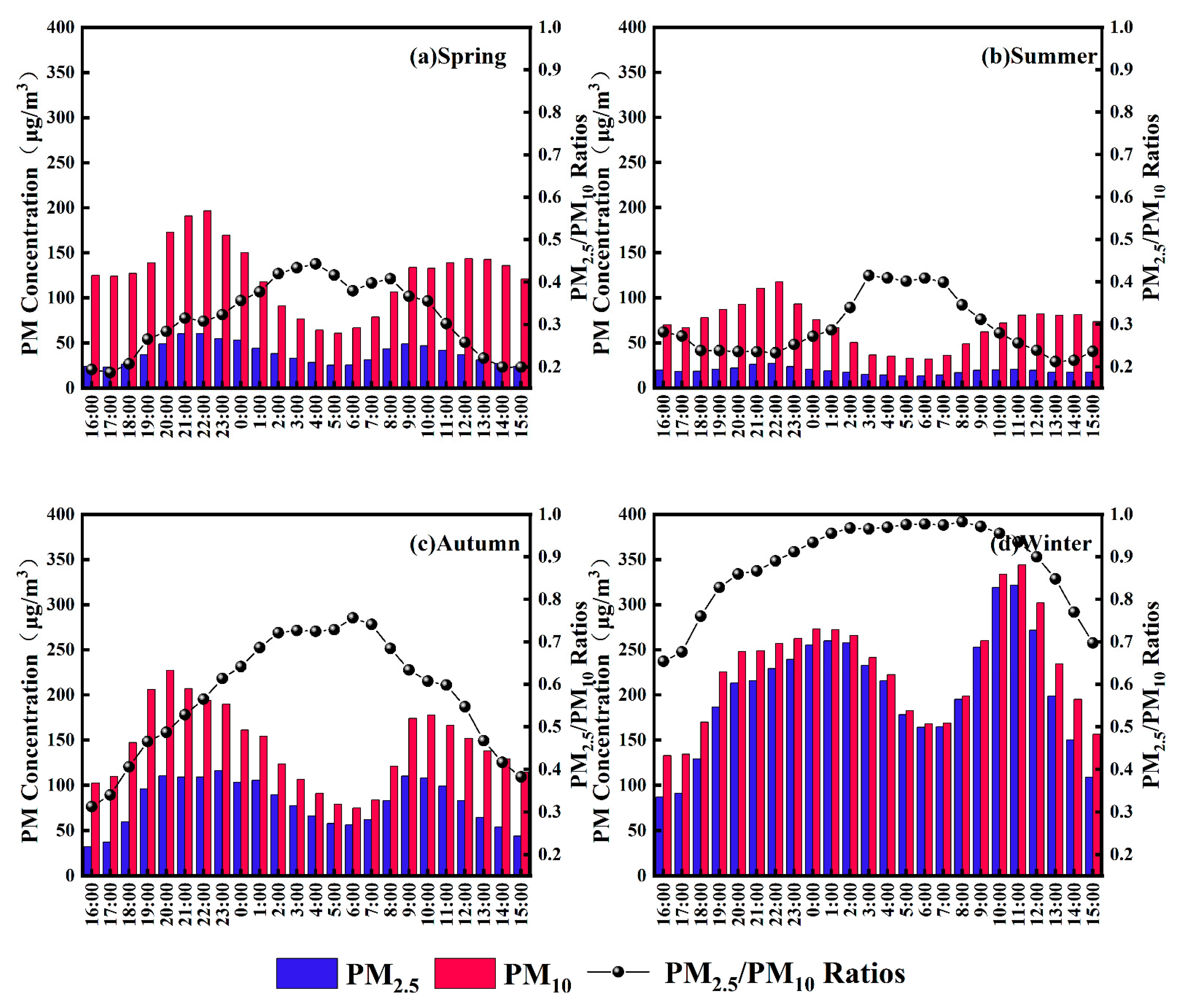
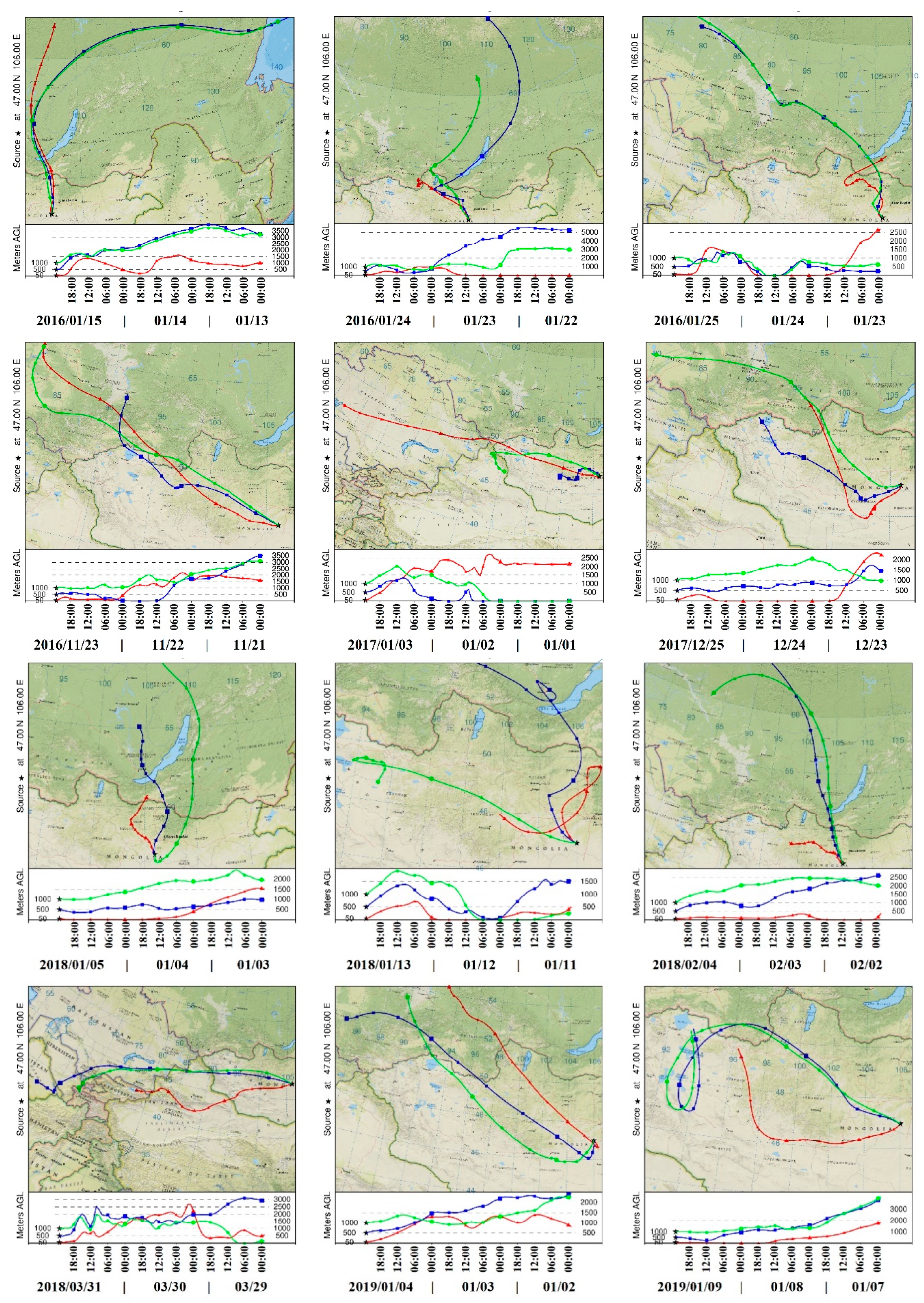
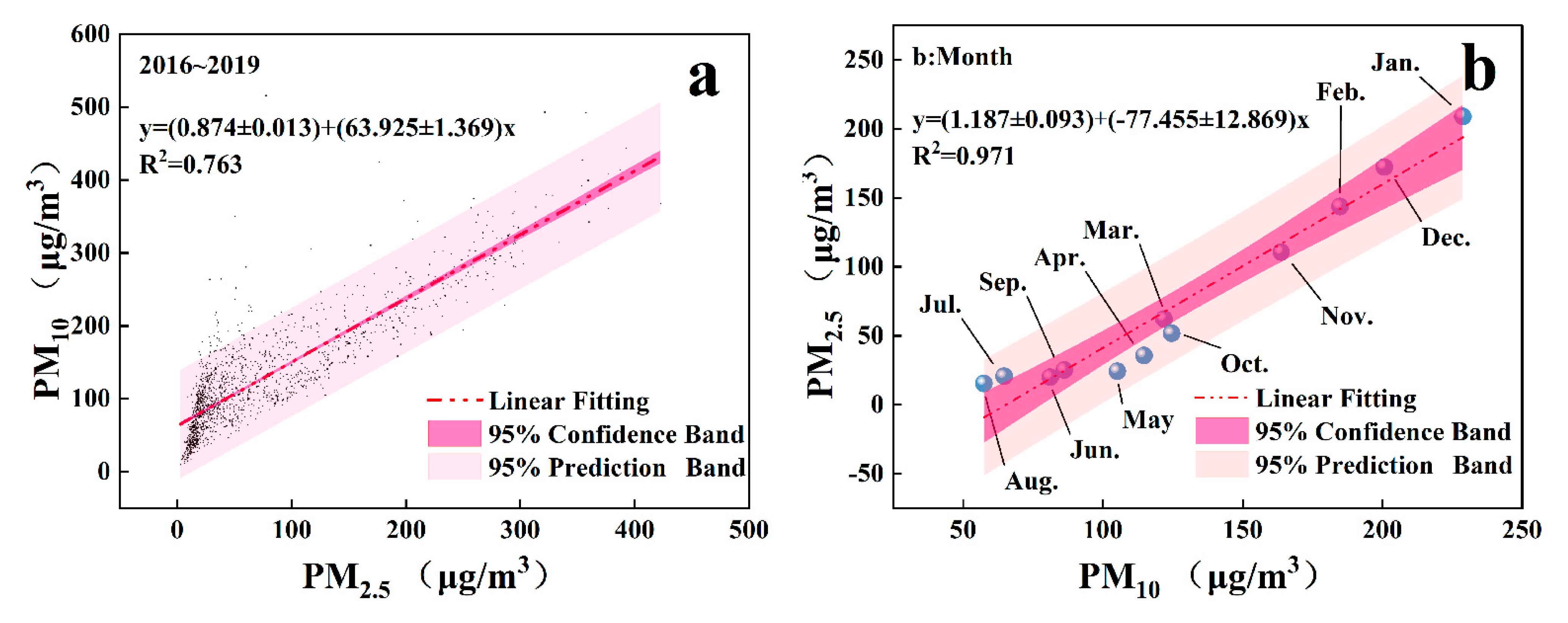

| AQI | Breakpoints | |||||||||
|---|---|---|---|---|---|---|---|---|---|---|
| SO2 μg/m3 24-h | SO2 μg/m3 1-h | NO2 μg/m3 24-h | NO2 μg/m3 1-h | PM10 μg/m3 24-h | PM2.5 μg/m3 24-h | CO mg/m3 8-h | CO mg/μm3 1-h | O3 μg/m3 8-h | O3 μg/m3 1-h | |
| 0–50 Good | - | 0–100 | - | 0–100 | 0–50 | 0–35 | 0–5 | - | 0–50 | - |
| 51–100 Moderate | - | 101–300 | - | 101–200 | 51–100 | 36–50 | 5–10 | 11–30 | 51–100 | - |
| 101–200 Unhealthy for Sensitive Groups | 50–800 | 301–800 | 50–280 | 201–700 | 101–300 | 51–150 | 11–15 | 31–60 | 101–265 | 250–400 |
| 201–300 Unhealthy | 801–1600 | 801–1600 | 281–565 | 701–2000 | 301–420 | 151–250 | 16–30 | 61–90 | 266–800 | 401–800 |
| 301–400 Very Unhealthy | 1601–2100 | 1601–2100 | 566–750 | 2001–3500 | 421–500 | 251–350 | 31–40 | 91–120 | - | 801–1000 |
| 401–500 Hazardous | 2101–2620 | 2101–2620 | 751–940 | 3501–3840 | 501–600, 601< | 351–500, 501< | 40–50 | 120–150 | - | 1001–1200 |
| Primary Pollutant | Year | Spring | Summer | Autumn | Winter | Total | ||||||||
|---|---|---|---|---|---|---|---|---|---|---|---|---|---|---|
| Mar. | Apr. | May | Jun. | Jul. | Aug. | Sep. | Oct. | Nov. | Dec. | Jan. | Feb. | |||
| PM2.5 | 2016 | 19 | - | - | - | 3 | - | 4 | 9 | 25 | 31 | 31 | 28 | 150 |
| 2017 | 17 | - | - | - | 1 | - | - | 17 | 28 | 31 | 30 | 27 | 151 | |
| 2018 | 13 | - | - | - | - | - | - | 4 | 15 | 30 | 31 | 25 | 118 | |
| 2019 | 8 | 1 | - | - | 1 | 1 | - | 1 | 14 | 29 | 31 | 27 | 113 | |
| Total | 58 | 6 | 117 | 351 | 532 | |||||||||
| Proportion (%) | 25% | 9% | 49% | 99% | ||||||||||
| PM10 | 2016 | 5 | 14 | 10 | 8 | 11 | 5 | 6 | 10 | 3 | - | - | - | 72 |
| 2017 | 7 | 22 | 16 | 12 | 5 | 1 | 7 | 8 | — | - | - | - | 78 | |
| 2018 | 10 | 17 | 21 | 6 | - | - | 8 | 19 | 13 | 1 | - | 1 | 96 | |
| 2019 | 20 | 16 | 12 | 8 | 1 | 1 | 15 | 21 | 10 | - | - | 1 | 105 | |
| Total | 170 | 58 | 120 | 3 | 351 | |||||||||
| Proportion (%) | 75% | 91% | 51% | 1% | ||||||||||
| Period | Urban Sites (mean ± st. dev., μg/m3) | Good and Moderate Days (mean ± st. dev., μg/m3) | ||||
|---|---|---|---|---|---|---|
| PM2.5 Conc. | PM10 Conc. | PM2.5/PM10 | PM2.5 Conc. | PM10 Conc. | PM2.5/PM10 | |
| Spring | 40 ± 17 | 114 ± 18 | 0.37 ± 0.14 | 20 ± 5 | 41 ± 3 | 0.49 ± 0.11 |
| Summer | 19 ± 4 | 68 ± 19 | 0.30 ± 0.05 | 13 ± 2 | 36 ± 3 | 0.36 ± 0.05 |
| Autumn | 63 ± 44 | 125 ± 40 | 0.47 ± 0.19 | 15 ± 3 | 38 ± 6 | 0.40 ± 0.10 |
| Winter | 175 ± 37 | 205 ± 34 | 0.85 ± 0.09 | 43 ± 6 | 61 ± 9 | 0.71 ± 0.14 |
| Full year | 74 ± 67 | 128 ± 57 | 0.50 ± 0.24 | 28 ± 21 | 49 ± 18 | 0.54 ± 0.24 |
| Season | Date | AQI | Prime Pollution | PM10 | PM2.5 | SO2 | NO2 | CO | O3 | PM2.5/ PM10 | Direction of the Wind |
|---|---|---|---|---|---|---|---|---|---|---|---|
| Spring | 31 March 2018 | 416 | PM10 | 516 | 78 | 15 | 39 | 0.7 | 42 | 0.15 | West |
| Summer | / | / | / | / | / | / | / | / | / | / | / |
| Autumn | 23 November 2016 | 418 | PM2.5 | 409 | 377 | 97 | 84 | 4.3 | 7 | 0.92 | Northwest |
| Winter | 15 January 2016 | 449 | PM2.5 | 368 | 423 | 161 | 81 | 4.3 | 5 | 1.15 | Shift from north to east |
| 24 January 2016 | 402 | PM2.5 | 392 | 353 | 165 | 70 | 3.8 | 7 | 0.9 | Shift from west to north | |
| 25 January 2016 | 425 | PM2.5 | 414 | 387 | 156 | 72 | 3.8 | 6 | 0.94 | Northwest (frequent wind shifts near the ground) | |
| 03 January 2017 | 428 | PM2.5 | 443 | 393 | 121 | 98 | 8.6 | 6 | 0.89 | Northwest | |
| 25 December 2017 | 405 | PM2.5 | 492 | 357 | 69 | 81 | 5.7 | 9 | 0.73 | Shift from southwest to north | |
| 05 January 2018 | 403 | PM2.5 | 427 | 354 | 74 | 65 | 3.8 | 10 | 0.83 | North | |
| 13 January 2018 | 405 | PM2.5 | 366 | 357 | 70 | 67 | 4.4 | 10 | 0.98 | Northwest (frequent wind shifts near the ground) | |
| 04 February 2018 | 418 | PM2.5 | 361 | 377 | 55 | 63 | 3.5 | 13 | 1.04 | North | |
| 04 January 2019 | 407 | PM2.5 | 343 | 360 | 71 | 61 | 4.0 | 7 | 1.05 | Northwest | |
| 09 January 2019 | 406 | PM2.5 | 399 | 359 | 100 | 81 | 5.1 | 26 | 0.90 | Shift from west to north (frequent wind shift at high altitude) |
| Season | PM10 | SO2 | NO2 | CO | O3 |
|---|---|---|---|---|---|
| Spring | 0.502 | 0.854 | 0.667 | 0.667 | −0.400 |
| Summer | 0.751 | 0.370 | 0.431 | 0.161 | 0.310 |
| Autumn | 0.883 | 0.883 | 0.909 | 0.921 | −0.800 |
| Winter | 0.938 | 0.403 | 0.630 | 0.726 | −0.559 |
Publisher’s Note: MDPI stays neutral with regard to jurisdictional claims in published maps and institutional affiliations. |
© 2022 by the authors. Licensee MDPI, Basel, Switzerland. This article is an open access article distributed under the terms and conditions of the Creative Commons Attribution (CC BY) license (https://creativecommons.org/licenses/by/4.0/).
Share and Cite
Suriya; Natsagdorj, N.; Aorigele; Zhou, H.; Sachurila. Spatiotemporal Variation in Air Pollution Characteristics and Influencing Factors in Ulaanbaatar from 2016 to 2019. Atmosphere 2022, 13, 990. https://doi.org/10.3390/atmos13060990
Suriya, Natsagdorj N, Aorigele, Zhou H, Sachurila. Spatiotemporal Variation in Air Pollution Characteristics and Influencing Factors in Ulaanbaatar from 2016 to 2019. Atmosphere. 2022; 13(6):990. https://doi.org/10.3390/atmos13060990
Chicago/Turabian StyleSuriya, Narantsogt Natsagdorj, Aorigele, Haijun Zhou, and Sachurila. 2022. "Spatiotemporal Variation in Air Pollution Characteristics and Influencing Factors in Ulaanbaatar from 2016 to 2019" Atmosphere 13, no. 6: 990. https://doi.org/10.3390/atmos13060990
APA StyleSuriya, Natsagdorj, N., Aorigele, Zhou, H., & Sachurila. (2022). Spatiotemporal Variation in Air Pollution Characteristics and Influencing Factors in Ulaanbaatar from 2016 to 2019. Atmosphere, 13(6), 990. https://doi.org/10.3390/atmos13060990






